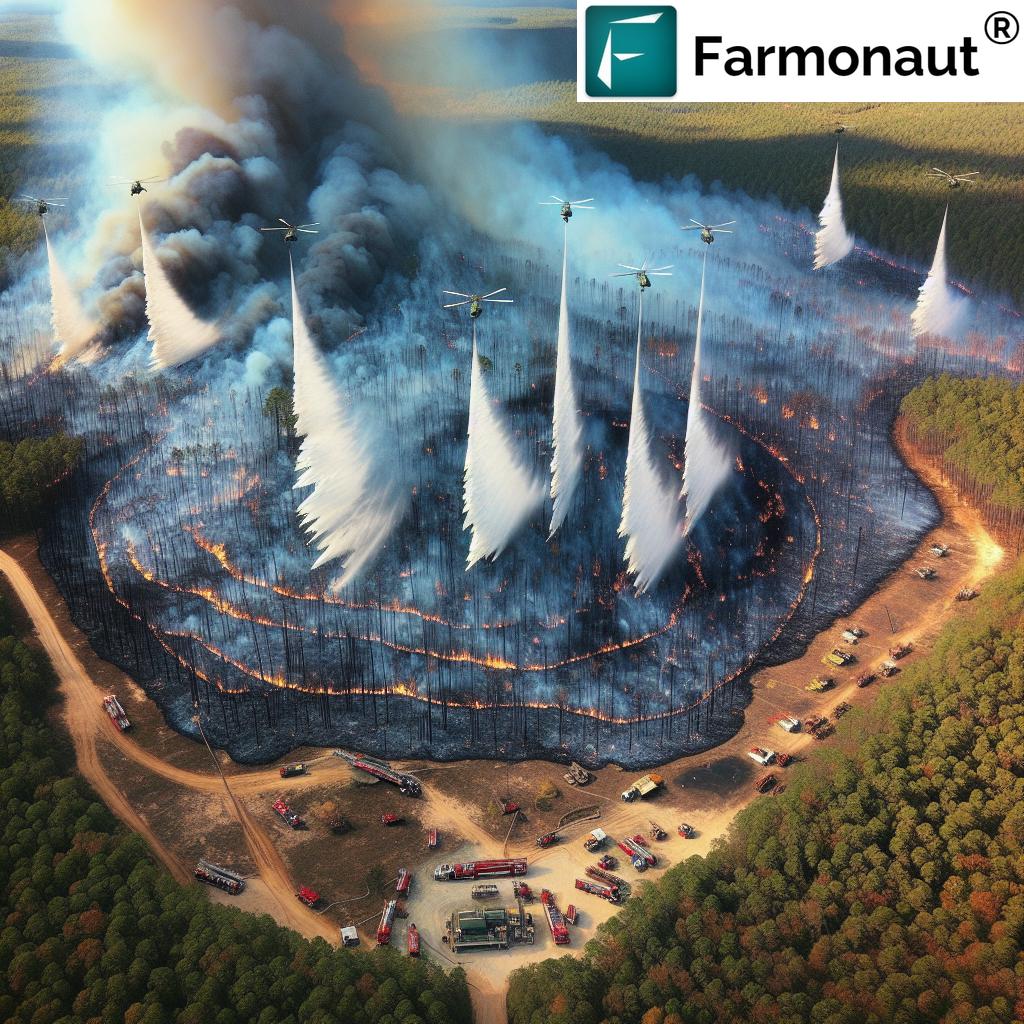Carolina Forest Fire Update: 70% Containment Achieved in Horry County Wildfire
“The Carolina Forest fire in Horry County, SC, has burned 2,059 acres but reached 70% containment after 14 days.”
As we approach the two-week mark of the devastating Carolina Forest fire in Horry County, South Carolina, we are pleased to report a significant milestone in the containment efforts. The South Carolina Forestry Commission has announced that crews have successfully achieved 70% containment of the 2,059-acre Covington Drive wildfire. This progress marks a crucial turning point in the battle against one of the most challenging forest fires the region has faced in recent years.
In this comprehensive blog post, we will delve into the latest updates on the Carolina Forest fire containment, explore the strategies employed by firefighters, and examine the impact of weather conditions on the wildfire’s behavior. We’ll also discuss the ongoing challenges faced by fire management teams and the implications of this significant environmental event for forest sustainability in the area.
The Current State of the Carolina Forest Fire
As we enter Day 14 of the wildfire, the situation has shown marked improvement. The South Carolina Forestry Commission reports that fire managers have increased containment to 70% after another successful day of operations. This progress is a testament to the tireless efforts of firefighters on the ground and the strategic use of aerial resources in combating the blaze.

The Covington Drive fire, which has affected 2,059 acres of the Carolina Forest area, continues to pose challenges. However, the increased containment percentage offers hope to residents and officials alike. Let’s take a closer look at the progress made over the past two weeks:
| Date | Containment Percentage | Acres Affected | Key Actions |
|---|---|---|---|
| Day 1 | 10% | 2,059 | Initial response and assessment |
| Day 7 | 40% | 2,059 | Expanded ground crew operations |
| Day 10 | 55% | 2,059 | Intensified aerial water drops |
| Day 14 | 70% | 2,059 | Focused efforts on remaining hot spots |
Firefighting Strategies and Resources
The success in containing the Carolina Forest fire can be attributed to a multi-faceted approach combining ground and aerial operations. Firefighters on the ground have been working tirelessly to create fire lines and directly combat the flames. Meanwhile, aerial resources have played a crucial role in providing support from above.
“Firefighters battling the Covington Drive wildfire use both ground crews and aerial resources to combat hot spots.”
Key strategies employed in the firefighting efforts include:
- Ground Operations: Crews have been scouting the fire area, identifying and extinguishing hot spots to prevent further spread.
- Water Application: Both ground teams and aerial units have been applying water to cool affected areas and suppress active flames.
- Perimeter Control: Firefighters have been working to establish and reinforce containment lines around the fire’s perimeter.
- Aerial Surveillance: Aircraft have been used to monitor the fire’s behavior and guide ground teams to critical areas.
The South Carolina Forestry Commission has been at the forefront of coordinating these efforts, ensuring that resources are deployed effectively and efficiently.
The Role of Weather in Wildfire Behavior
Weather conditions play a significant role in the behavior and management of wildfires. In the case of the Carolina Forest fire, changing weather patterns have presented both challenges and opportunities for firefighting efforts.
The Forestry Commission has noted that residents may notice increased smoke, particularly in the evening hours. This is due to a combination of factors:
- Humid Air: Increased humidity can trap smoke closer to the ground, making it more noticeable to nearby communities.
- Changing Weather: Incoming weather systems can affect wind patterns and atmospheric stability, influencing smoke dispersal.
Understanding these weather-related factors is crucial for both firefighters and residents. Fire management teams must adapt their strategies based on forecasted conditions, while local communities need to stay informed about potential air quality issues.
For those interested in staying updated on weather conditions and their potential impact on the wildfire, tools like Farmonaut’s weather data services can provide valuable insights. While not specifically designed for wildfire management, these agricultural technology solutions offer accurate weather forecasts that can be beneficial for understanding local conditions.
Environmental Impact and Forest Sustainability
As we continue to monitor the Carolina Forest fire containment efforts, it’s essential to consider the broader environmental implications of this event. Wildfires, while often devastating in the short term, can play a complex role in forest ecosystems.
Some key environmental considerations include:
- Habitat Disruption: The fire has undoubtedly impacted local wildlife habitats and plant communities.
- Soil Health: Intense fires can affect soil composition and nutrient levels, influencing future vegetation growth.
- Carbon Release: Large-scale fires contribute to carbon emissions, a concern in the context of climate change.
- Forest Regeneration: In some cases, fires can promote new growth and increase biodiversity in the long term.
As we look towards the future, forest management practices will need to adapt to the increasing frequency and intensity of wildfires. This may involve strategies such as controlled burns, improved fire breaks, and the cultivation of fire-resistant plant species.

Community Impact and Safety Measures
The Carolina Forest fire has had a significant impact on local communities in Horry County. As containment efforts progress, it’s crucial for residents to remain vigilant and follow safety guidelines provided by local authorities.
Key safety considerations for residents include:
- Air Quality Awareness: Monitor local air quality reports and take precautions if smoke levels increase.
- Evacuation Readiness: Stay informed about any evacuation orders and have an emergency plan in place.
- Property Protection: Follow guidelines for creating defensible spaces around homes in fire-prone areas.
- Community Support: Check on neighbors, especially those who may need assistance during emergencies.
Local authorities continue to provide updates and resources for affected communities. Residents are encouraged to stay informed through official channels and follow all safety recommendations.
The Role of Technology in Wildfire Management
In recent years, technological advancements have played an increasingly important role in wildfire management and prevention. While our focus is on the Carolina Forest fire, it’s worth noting how various technologies are being employed in similar situations across the country.
Some key technological applications in wildfire management include:
- Satellite Imagery: Used for early detection and monitoring of fire spread.
- Drones: Employed for aerial surveillance and mapping of fire perimeters.
- AI and Machine Learning: Help predict fire behavior and optimize resource allocation.
- Mobile Apps: Provide real-time updates and safety information to communities.
While not directly related to wildfire management, companies like Farmonaut are pioneering the use of satellite technology in agriculture. Their expertise in analyzing satellite imagery for crop health monitoring demonstrates the potential for similar technologies to be adapted for forest management and fire prevention.
Lessons Learned and Future Preparedness
As we approach the potential resolution of the Carolina Forest fire, it’s important to reflect on the lessons learned from this event. These insights can help improve wildfire prevention and management strategies for the future.
Key takeaways include:
- Early Detection: The importance of early warning systems and rapid response capabilities.
- Resource Coordination: Effective coordination between local, state, and federal agencies is crucial for successful firefighting efforts.
- Community Preparedness: Educating and preparing communities in fire-prone areas can significantly improve safety and response times.
- Ecological Management: The need for sustainable forest management practices that reduce fire risk while maintaining ecosystem health.
Moving forward, it will be essential for forest management agencies, local communities, and technology providers to work together in developing comprehensive wildfire prevention and response strategies.
Conclusion: A Turning Point in the Carolina Forest Fire Containment
The achievement of 70% containment in the Carolina Forest fire marks a significant milestone in the ongoing efforts to control this devastating wildfire. While challenges remain, the progress made by firefighters and support teams offers hope to the affected communities in Horry County.
As we continue to monitor the situation, it’s clear that the combined efforts of ground crews, aerial resources, and advanced technologies have played a crucial role in managing this fire. The lessons learned from this event will undoubtedly shape future approaches to wildfire management and forest sustainability in South Carolina and beyond.
We encourage residents to stay informed, follow safety guidelines, and support the ongoing efforts of firefighters and emergency responders. Together, we can work towards a future where our forests are more resilient and our communities are better prepared to face the challenges of wildfires.
FAQs about the Carolina Forest Fire
- Q: How large is the Carolina Forest fire?
A: The fire has affected 2,059 acres in the Covington Drive area of Carolina Forest, Horry County. - Q: What percentage of the fire is currently contained?
A: As of Day 14, the fire is 70% contained. - Q: Are there any current evacuation orders?
A: For the most up-to-date information on evacuation orders, please check with local authorities or the South Carolina Forestry Commission. - Q: How can residents stay informed about the fire’s progress?
A: Follow official channels such as the South Carolina Forestry Commission’s website and social media accounts for regular updates. - Q: What should residents do if they notice increased smoke?
A: Stay indoors if possible, close windows, and follow air quality advisories issued by local health departments.
Stay informed and stay safe as we continue to monitor the progress of the Carolina Forest fire containment efforts.
For developers interested in integrating weather data into their applications, check out the Farmonaut API and the API Developer Docs.





